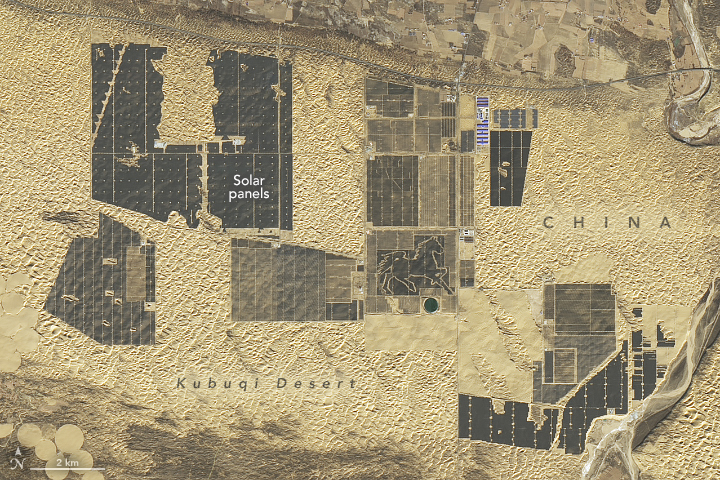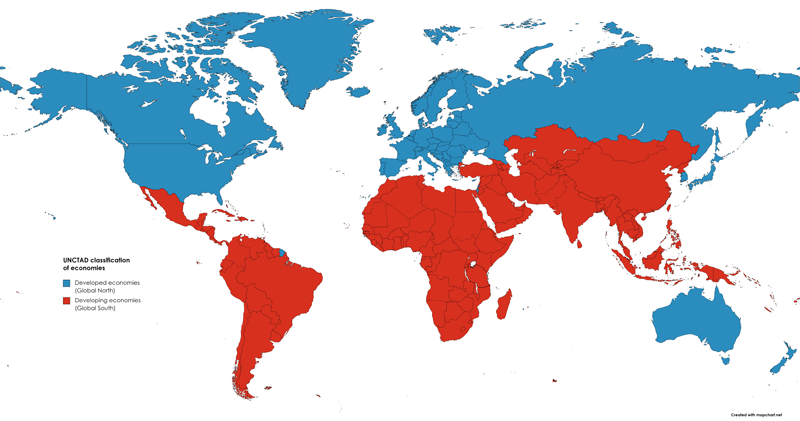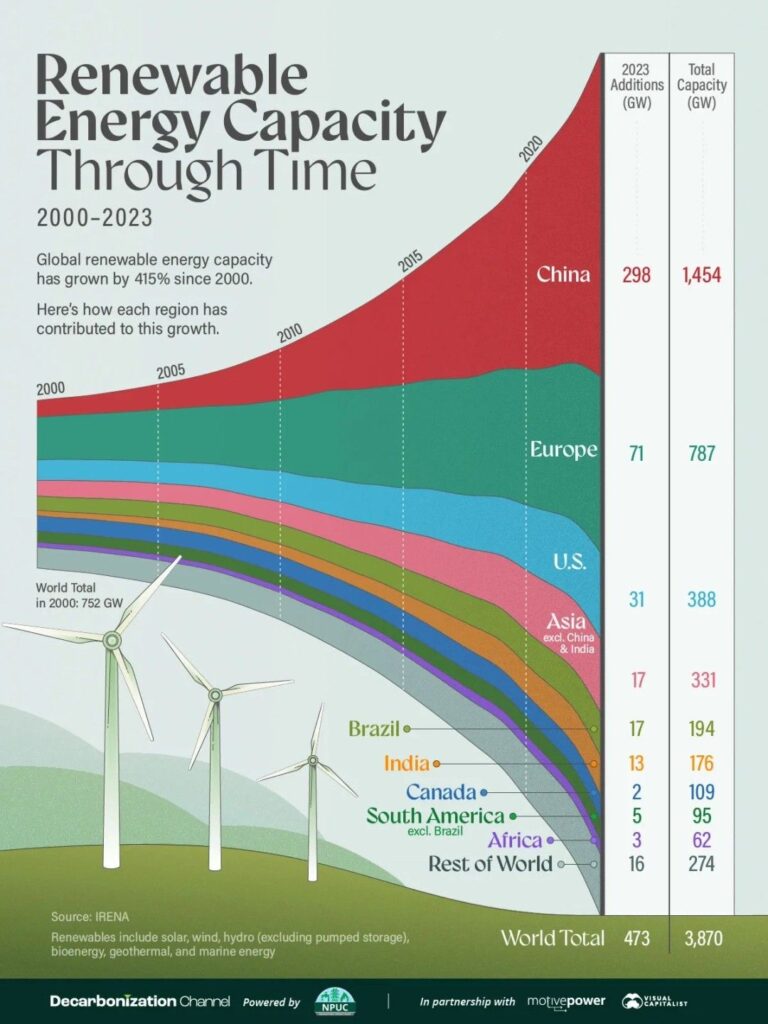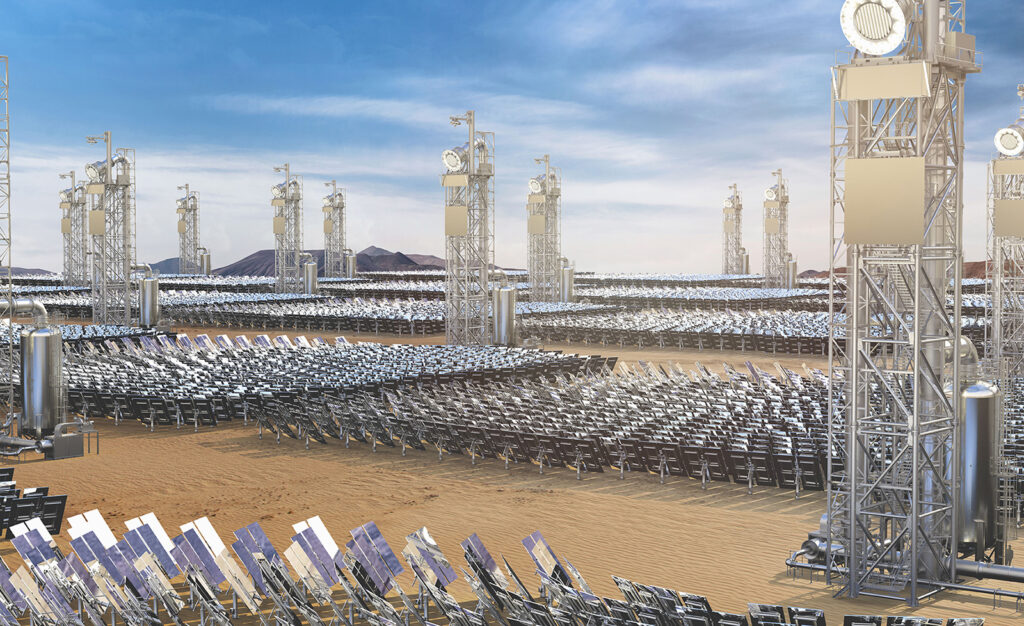ENVIRONMENTAL BENEFITS OF SOLAR GO BEYOND CLEAN POWER

USGS/NASA
China leads the world in solar. As reported by Newsweek, China deployed nearly 40,000 megawatts of solar capacity annually between 2017 and 2023, nearly five times the growth in the second-place U.S., which added approximately 8,100 megawatts annually during the same period.
To put this unprecedented expansion in perspective, Newsweek’s Tom Howarth highlights a remarkable transformation taking place in China’s Kubuqui Desert in Inner Mongolia. There, in a project dubbed China’s “solar great wall,” vast fields of photovoltaic panels are being built. They are expected to stretch 250 miles in length and 3 miles in width, with a maximum capacity of 100 gigawatts, by the end of this decade. This is, in Howarth’s words, “enough to power Beijing and beyond.”
And there’s more. Chinese researchers, studying the environmental effects of such massive deployments, have made surprising findings. While critics claim that large solar fields can damage the ecosystems where they are sited, the researchers found just the opposite, at least as far as desert locations are concerned.
Beneficial effects
In a paper published in Scientific Reports, the research team found that large-scale solar installations in desert environments can have a positive impact on the local ecosystem, fostering improved microclimate, soil conditions, and biodiversity.
Among the benefits:
- Positive Microclimate Changes: Solar panels can act as shade and windbreaks, leading to increased soil moisture retention and reduced evaporation, creating a more favorable environment for plant growth.
- Improved Soil Conditions: The presence of solar panels can modify the soil surface, enhancing its physical and chemical properties, leading to increased soil fertility and nutrient availability.
- Increased Plant Diversity: The creation of a more favorable microclimate and improved soil conditions can lead to an increase in plant diversity and vegetation cover in the areas under and around solar panels.
- Enhanced Microbial Communities: Solar panels can impact the microbial communities in the soil, fostering a more diverse and active microbial ecosystem.
- Desertification Mitigation: The positive effects on soil and vegetation can contribute to desertification mitigation and land restoration in arid and semi-arid regions.
Multiple mechanisms
How do the researchers say these benefits come about? Solar panels can provide shade and reduce wind speed, reducing soil erosion and enhancing moisture retention. The presence of solar panels can alter surface temperature patterns, impacting local microclimates and influencing vegetation growth. The reduced wind speed and increased soil moisture retention in turn contribute to improved soil conditions and plant growth. Solar panels can also reduce evaporation rates, leading to a more humid microclimate and increased water availability for plants.
Taken together, the findings suggest that solar energy projects can play a role in mitigating desertification and improving the resilience of arid and semi-arid ecosystems. Positive changes in soil conditions, vegetation cover, and biodiversity can also enhance environmental “services” provided by desert ecosystems, including carbon sequestration, water regulation, and biodiversity conservation.
Read more here.
ROUND-THE-CLOCK CLEAN CLEAN ELECTRICITY AND HEAT
400kWe 247Solar Plants deployed at scale
247Solar Plants™ bridge the gap between conventional wind and solar and the need for round-the-clock utility power and industrial-grade heat. 247Solar Plants store the sun’s energy as heat instead of electricity, for 18 hours or more, at much less than the cost of batteries. No generators are required, and 247Solar’s turbines can also burn a variety of fuels, including hydrogen, to ensure 24/7/365 dispatchability.
Extensive Applications
On-grid or off-grid, 247Solar Plants offer a 24/7 alternative to fossil fuels for a broad range of applications:
- CHP: 24/7 low-carbon Combined Heat & Power for industry
- Ultra Heat: Each 247Solar Plant can provide up to 1,500,000 Btu/hr. of heat at temperatures up 1000℃/1800℉ for industrial processes such as cement, glass, steel making, or minerals processing
- Microgrids: Always-on, emissions-free electricity and heat for islands, mines, communities, facilities
- 24/7 baseload power: 24/7 solar electricity, especially for emerging economies
- Green Hydrogen: 24/7 solar electricity and heat to power electrolysis around the clock
- Green Desalination: 24/7 solar electricity and heat to purify water around the clock
GLOBAL SOUTH ADOPTING CLEANTECH FASTER THAN GLOBAL NORTH

By Specialgst/mapchart.net
A new report from the Rocky Mountain Institute shows the Global South is adopting cleantech faster than the Global North. In Powering Up the Global South, RMI illustrates that Global South countries are deploying cleantech rapidly and projects they will continue to do so as their path to growth.
A summary on RMI’s website says its research shows that three-quarters of the Global South’s energy demand is in the “sweet spot” of change based on their level of fossil fuel imports, income, energy demand, and available renewable resources. Other findings:
- With 60 percent of the global population, the Global South has only 20 percent of fossil fuel production and reserves, and oil and gas production are in decline. As a result, it is already a net importer of fossil fuels. In contrast, the Global South is rich in renewables, with 70 percent of global renewable potential.
- In 2024, 87 percent of capital expenditures on electricity generation will go into clean energy. Over the past five years, solar and wind generation in the Global South has grown on average at 23 percent annually, now supplying 9 percent of its electricity. Global South solar and wind adoption is only five years behind the Global North.
- One-fifth of the Global South, from Brazil to Morocco and Namibia, from Bangladesh to Egypt and Vietnam, has already overtaken the Global North in terms of the share of solar and wind in electricity generation, or the share of electricity in final energy.
The authors say, “While there are grounds for optimism, more action is needed to speed up change.” Recommended solutions include domestic policy, reform of development banks, catalytic and concessional finance directed especially to poor and vulnerable countries, and technology transfer.
Download the report here
GLOBAL RENEWABLE ENERGY CAPACITY HAS GROWN BY 415% SINCE 2000

Sustainability Infographics/Decarbonization Channel
Regular readers will know we like to include an interesting chart or other visual in each issue. Here’s one from Sustainability Infographics and Decarbonization Channel, showing the rise in renewable energy capacity across countries and regions since 2000.
Key Takeaways
- Global renewable energy capacity has grown by 415% since 2000, averaging 17% per year.
- China’s growth in renewables is slowing. While their average annual growth since 2000 has been 76% per year, their growth between 2022 and 2023 was down to 26%.
Canada has fared significantly worse than the rest of the developed world between 2000 and 2023; the country’s renewable capacity grew only by 57%, or an average of 2% annually.
FOLLOW & JOIN 247Solar
Contact: info@247solar.com
